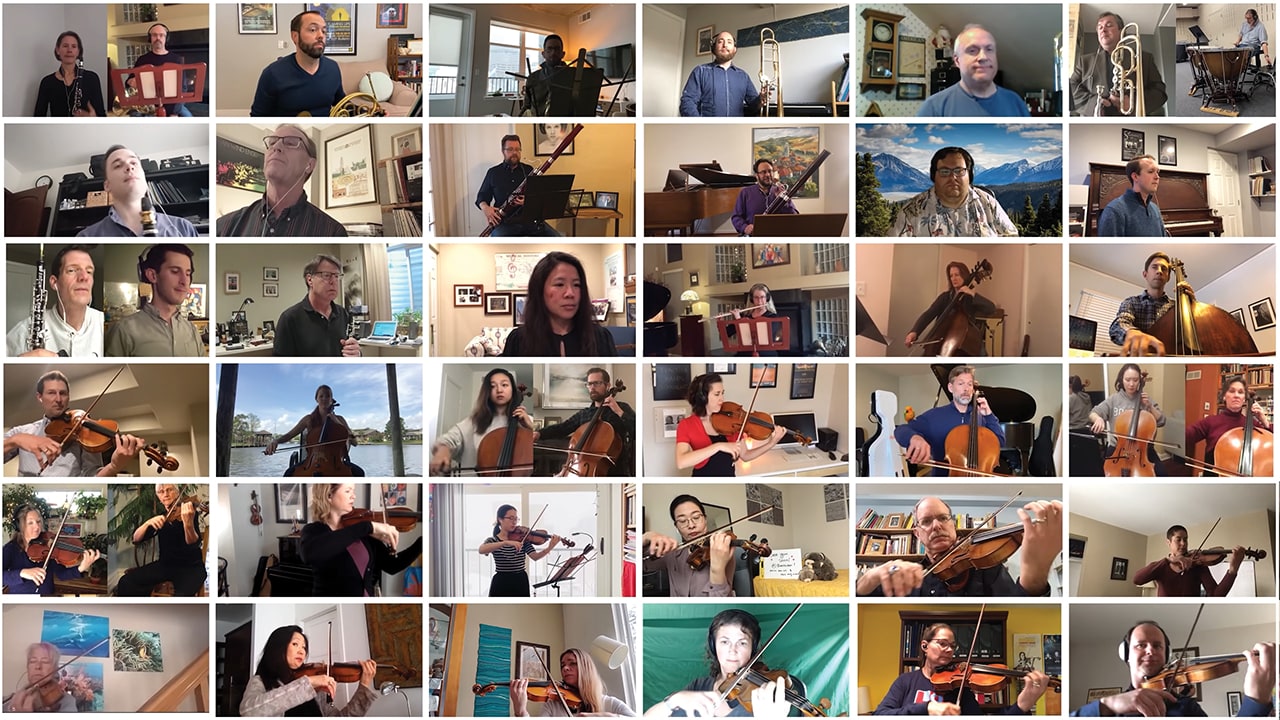
Extraordinary Teamwork
Tuesday, March 21, 2023
Early in the COVID-19 pandemic, online meetings delivered over digital platforms such as Zoom suddenly became ubiquitous — in our work lives, in our social lives, and as a way to experience the outside world from the safety of our homes.
In one particularly memorable moment in March 2020, millions of people shared in a moving Zoom-delivered musical experience as performances by symphony orchestras, such as the Colorado Symphony's digital "Ode to Joy," were recorded and posted online, with each musician remote from the others yet perfectly in sync and creating a much-needed sense of togetherness and connection. It was a spectacular illustration of creativity and innovation delivered under extremely challenging circumstances. And it was a demonstration of extraordinary teamwork.
One aspect that made this experience — and symphony orchestras in general — so magical is the variety of instruments and perspectives brought by musicians mastering vastly different sounds and techniques.
Imagine if only one type of instrument existed for creating music — perhaps only drums or only violins. Would the "Ode to Joy" performance have had the same impact? While the drum and the violin are each phenomenal instruments, the impact of that moment was created by different instruments being introduced and integrated into the whole. It's the diversity that made it magical.
And so it is with teams in the workplace. While like-minded people, all with similar training and worldviews, can work together and produce great outcomes, a combination of different perspectives is required for ground-breaking innovations and next-level performance.
Why Diversity?
How does diversity contribute to team performance and innovation? As with the musical analogy, diversity brings unique experiences, and information to the table.
People who have lived significantly different experiences will see the world through different lenses, and they'll raise issues and suggest solutions that others simply are unlikely to consider. Research shows that bringing together diverse perspectives increases creativity by causing people to search for new information when they are confronted with these perspectives, and determines better decisions and solutions. In fact, the very exposure to people who we expect to hold different views from our own can change the way we think. It forces us out of our comfort zones. And thinking differently is often a path to better outcomes.
The very exposure to people who we expect to hold different views from our own can change the way we think. It forces us out of our comfort zones. And thinking differently is often a path to better outcomes.
To illustrate this notion, consider something as simple as city sidewalks. Originally designed for people with full mobility, sidewalks were built as structures slightly elevated above ground level. But when injured World War II veterans returning home to Kalamazoo, Michigan, needed to navigate their city’s terrain to search for jobs, everyday sidewalks became an obstacle. That is, until the introduction of curb cuts — sections of sidewalk built at ground level, sloping upwardly at a gentle incline to meet the level of the main curb. This innovation was life-transforming for returning veterans, enabling them to become employable, and it took a different worldview for it to come to fruition.
And, as anyone who has had to navigate sidewalks while pushing a baby stroller, using crutches or pulling luggage can attest, this innovation, which was only imagined because of a wheelchair-bound veteran’s experience, has come to benefit many.
Other examples abound, such as closed-captioned television and video transcription. Originally designed to help the hearing-impaired, it also benefits those in locations not conducive to listening to audio, non-native speakers of the language, and fans watching their favorite sports teams battle it out in noisy locations. Such innovations that ultimately benefit many came into being only because people with unique life experiences saw a need and envisioned a solution.
The Benefits of Diverse Teams
Many studies have examined the relationship between diverse teams and performance, and collectively, these studies provide evidence of a positive association.
For example, firms with women in decision-making leadership positions demonstrate stronger financial performance than firms with only men in leadership roles, and when ethnic diversity is added to the mix, the performance boost is even higher. Evidence from well-designed research studies1, with random assignment to control and experimental groups, provides even more compelling evidence: Across a number of domains (such as solving a mystery or participating in a mock jury), diverse groups outperform their homogenous counterparts.

This line of research also helps explain why that’s the case. For example, in a study focused on small-group decision- making, team members were provided with different bits of information relevant to the task. Each member shared a common set of information, and each had unique information known only to them. In order to arrive at the best decision, team members had to share their unique information. Unlike the diverse (mixed race) groups, members of homogenous (all- white) groups assumed that each team member had the same information, so they didn’t interact in a way that revealed their unique knowledge. Their sameness inhibited creative thinking and reaching the correct solution.
Similar findings have been observed across a range of individual differences and settings, including lab research with people of different political party affiliations, field studies comparing geographic diversity and real-life situations where skin color is the difference factor. Taken as a whole, it's evident that being exposed to people with different life experiences and different points of view has a powerful effect on causing us to think more deeply and process information at a different level than we do when everyone around us thinks the same way we do.
I have experienced this dynamic first hand. Throughout the course of a writing project with two co-authors (both male, from a country other than mine), we encountered instances where two of the three were aligned on how to approach a topic, while the third saw things completely differently. In other instances, the same dynamic played out but with a different two-versus-one grouping. In all instances, the process of forcing ourselves to challenge our strongly held points of view led ultimately to an agreement and, importantly, to a better end product.
In another instance, I had the opportunity to question a project team about the technology solution they were delivering, where I saw risks that hadn’t occurred to the team. I viewed the technology through the lens of where things could potentially go awry and yield unexpected outcomes for different groups of people. By bringing that different perspective (based on my training as an industrial-organizational psychologist), we were able to demonstrate that the risk was real and to advise on mitigating actions. The result was a better experience and more accurate outcomes for all stakeholders involved.
Better Outcomes, Challenging Process
These scenarios further illustrate the value of bringing together teams with diverse perspectives based on different experiences. But the process is not always easy. Many times, in both of those scenarios, the inability to see eye-to-eye was frustrating, to say the least, and required perseverance to work through the differences. This is not atypical.
While diverse teams are more likely to deliver better outcomes, it is not necessarily the case that people will therefore prefer working with people who bring varying perspectives. The deeper processing of information that's ignited by exposure to people who are different, while clearly beneficial, is also cognitively challenging. It's hard work!
It’s enjoyable to be with people who share our views. But while it’s easier, this type of collaboration does not evoke the deep thinking required to get to better outcomes.
In contrast, when we're in a group where everyone thinks the same way we do, collaborating is more likely to be easy and fun. It's enjoyable to be with people who share our views. But while it's easier, this type of collaboration does not evoke the deep thinking required to get to better outcomes.
Think Diversely About Diversity
While much of the diversity conversation rightly centers around demographic characteristics — age, gender, race, ethnicity, disability, and more — it's useful to think even more broadly about the types of diversity that can be considered in the context of teams.
For example, teams spanning multiple nationalities bring valuable varying perspectives, particularly for organizations with global operations serving international constituents. Investing the time to meaningfully understand and appreciate different cultural norms, expectations, ways of working and language nuances can pay huge dividends in better team performance, as well as overcoming the challenges often associated with working among people whose experiences differ from our own.
As another example, cross-disciplinary backgrounds (such as teaming psychologists with technologists) can fuel innovative breakthroughs by challenging the way we view problems and the ways to solve them.
The hybrid world of working that many organizations have adopted out of necessity emerging from the pandemic brings yet another diversity challenge to the forefront: how to work effectively when some team members are office-based and co-located, while others are remote and collaborating virtually. Combining the talents of both types of workers — remote and in-office — requires intention and commitment, but the hard work required for effectively managing diverse ways of working can pay similar dividends to the hard work required to realize the value of other types of diversity in teams.
Placing ourselves in both scenarios — joining in-person teams as a remote worker, and alternately, working in an office while team members are remote — can facilitate an understanding of each group's unique challenges and how best to overcome them.
Doing The Work, Reaping The Benefits
Innovation and superior results require hard work. "Easy" does not lead to innovation and greatness; it leads to stagnation, sameness and complacency. Rather, it's doing the work of bringing together differing perspectives, and navigating through those differences, that leads to innovation and superior results.
Footnote:
1 See, for example, Katherine W. Phillips, How Diversity Makes Us Smarter, Scientific American, October 1, 2014.
This article originally appeared in the Spring 2023 issue of In the Lead magazine, from The Stillman School of Business and its Business Leadership Center. The bi-annual magazine focuses on leadership perspectives from the field of health care, with content that is curated from leaders across the industry who share lessons learned from real-world experiences.
Categories: Business
